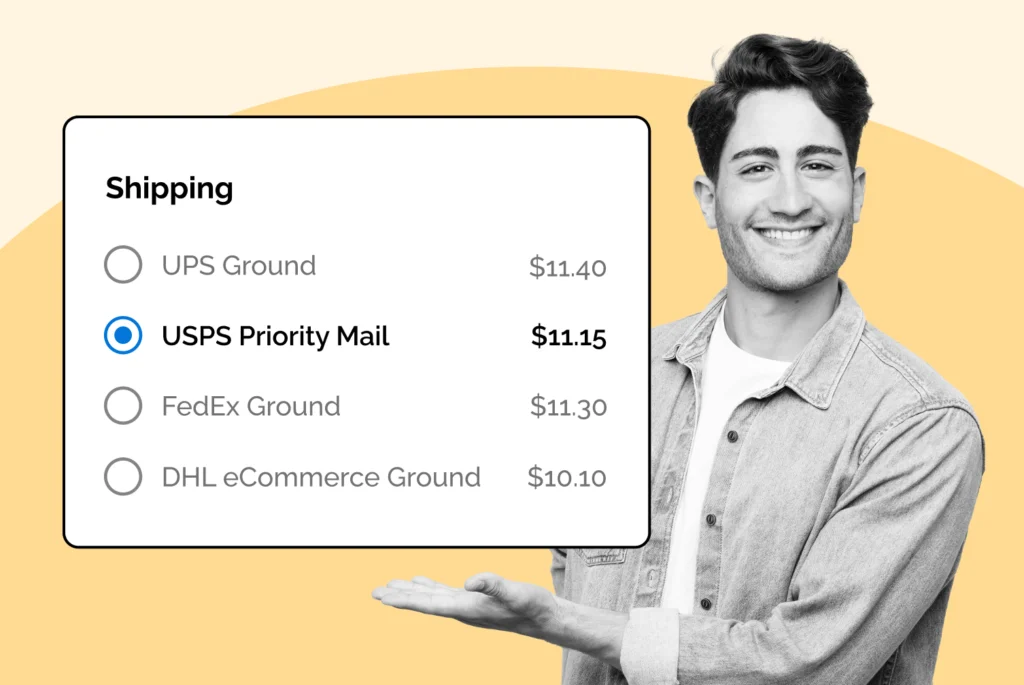
How to Calculate Shipping Costs Across USPS, UPS, FedEx, and DHL
Learn how to accurately calculate shipping costs with our essential guide. Get practical tips and tools to ensure your estimates are spot on.
Shipping, Tracking & Notifications
Boost customer experience and reduce support tickets
Realtime order and shipment tracking
Proactive order and shipping notifications
AI-Enhanced Discounted Labels
Predictive pre-purchase estimated delivery dates
Self-Serivce branded order tracking
Effortless experience delivered
Identify and Resolve Order Issues
Realtime order and shipment tracking
Make returns profitable and delight customers
Flexibility to define any return destinations & conditions
Simplify returns for your customers and team
Incentivize exchanges over returns
Returns management made easy for your team
Returns management made easy for your team
Easy claims and smart upsells
Understand why your customers are returning
In-Store & Curbside Pickup
Unify the online and the in-store experience
Hassle-free pickup experience for customers
In-Store dashboard to keep operations streamlined
In-Store and Online orders unified
Drive foot-traffic to your stores
Shipping, Tracking & Notifications
Boost customer experience and reduce support tickets
Realtime order and shipment tracking
Proactive order and shipping notifications
AI-Enhanced Discounted Labels
Predictive pre-purchase estimated delivery dates
Self-Serivce branded order tracking
Effortless experience delivered
Identify and Resolve Order Issues
Realtime order and shipment tracking
Make returns profitable and delight customers
Flexibility to define any return destinations & conditions
Simplify returns for your customers and team
Incentivize exchanges over returns
Returns management made easy for your team
Returns management made easy for your team
Understand why your customers are returning
In-Store & Curbside Pickup
Unify the online and the in-store experience
Hassle-free pickup experience for customers
In-Store Dashboard to keep operations streamlined
In-Store and Online orders unified
Drive foot-traffic to your stores
Boost customer experience and reduce support tickets
Realtime order and shipment tracking
Proactive order and shipping notifications
AI-Enhanced Discounted Labels
Predictive pre-purchase estimated delivery dates
Self-Serivce branded order tracking
Effortless experience delivered
Make returns profitable and delight customers
Flexibility to define any return destinations & conditions
Simplify returns for your customers and team
Incentivize exchanges over returns
Returns management made easy for your team
Equip your team for precise return checks.
Easy claims and smart upsells
Understand why your customers are returning
Unify the online and the in-store experience
Hassle-free pickup experience for customers
In-Store Dashboard to keep operations streamlined
In-Store and Online orders unified
Drive foot-traffic to your stores
Find the answer to all your questions
Take a step by step trip through our functionality to see how we can improve your ecommerce processes.
Explore the most comon questions about WeSupply
Calculate the ROI that WeSupply can bring you
Request a no strings attached review of your current shopping experience and missed conversion opportunities
Read actionable articles on how to optimize your post-purchase experience and decrease support tickets
Get inspired by stories of how our customers implemented an effortless post-purchase experience
Wondering if WeSupply is a good fit for you? Read through our use cases to see how we can help you increase conversion & improve CX!
A Deep Dive into Top Companies' Order Tracking & Returns Strategy
Find the answer to all your questions
Explore the most comon questions about WeSupply
Calculate the ROI that WeSupply can bring you
Request a no strings attached review of your current shopping experience and missed conversion opportunities
Take a step by step trip through our functionality to see how we can improve your ecommerce processes.
Read actionable articles on how to optimize your post-purchase experience and decrease support tickets
Get inspired by stories of how our customers implemented an effortless post-purchase experience
A Deep Dive into Top Companies' Order Tracking & Returns Strategy
Wondering if WeSupply is a good fit for you? Read through our use cases to see how we can help you increase conversion & improve CX!

Every year, the holiday season brings a huge increase in shipping. Millions of people order gifts online, and businesses rush to send out products. This flood of packages creates stress for shipping companies like FedEx, UPS, and USPS. To manage the extra demand, they add special fees called peak season surcharges.
These surcharges are temporary but can be expensive. In 2025, they will run longer than ever, starting in late September and lasting until mid-January 2026. That means almost four months of extra costs. For businesses, this is more than just a small annoyance. It can take a big bite out of profits if not planned for. During the busiest shipping periods, peak season surcharges can significantly increase overall shipping expenses and shipping costs for businesses, making it crucial to understand and prepare for these added fees.
To give some perspective, UPS delivered 1.7 billion packages during the 2023 holiday season. FedEx reported similar numbers. With that kind of volume, even a small extra fee of $0.40 per package can quickly add up to thousands or even millions of dollars for larger shippers. Understanding how these surcharges work, and preparing for them, is the best way to avoid surprises and keep costs under control.
So what exactly are peak season surcharges? They are extra fees carriers charge during the busiest shipping times of the year. These fees cover things like hiring seasonal workers, renting extra trucks, and dealing with higher fuel use. Peak surcharges and peak fees are implemented to help carriers manage capacity constraints and increased operational costs during high-demand periods.
For most parcel carriers, the peak season is tied to holiday shopping. It usually starts in late September or early October and continues through the New Year. The most expensive weeks are late November and December, when Black Friday, Cyber Monday, and Christmas orders all pile up. During these periods, carriers may also apply a demand surcharge, which can vary based on shipping volume, package size, and destination.
It’s not just parcel carriers that use these fees. Ocean freight companies also add their own surcharges earlier in the year, usually from June to October, when retailers are shipping big inventories of goods from overseas to prepare for holiday sales.
The important thing to know is this: peak season surcharges are not optional. If you ship during these times, you will pay more. These surcharges can significantly increase parcel shipping costs, especially when demand surcharge rates fluctuate. The only question is how much more, and whether you can take steps to limit those costs.
Demand surcharges are the most common. They are applied to many shipments during high-demand weeks, especially to residential deliveries. Residential delivery surcharges, such as the residential delivery charge, are applied to domestic shipments and can adjust dynamically based on weekly shipping volume. For example, in 2025 FedEx will add $0.40 to $0.65 per package for ground residential shipments, while UPS will charge up to $2.05 per package and even more for very high-volume shippers. UPS applies additional fees to UPS Ground Residential shipments, and FedEx imposes surcharges on FedEx Ground Economy packages, FedEx Ground Economy, and FedEx Home Delivery services. Air residential shipments are also subject to demand surcharges during peak season.
The fees can get extreme for packages that are large, heavy, or irregular. FedEx’s “Ground Unauthorized Package Charge” in 2025 can reach $545 per package. That’s more than the value of many of the products being shipped.
High-volume shippers face another challenge. FedEx and UPS both use a system that compares your current weekly shipments to a baseline from the summer (usually June). If your holiday shipping goes far above that baseline, extra surcharges kick in. These residential delivery surcharges can rise week by week and are adjusted dynamically, making costs unpredictable.
Packages that don’t fit neatly on conveyor belts or need special handling are subject to an extra fee known as the additional handling surcharge. This includes boxes that are too heavy, too long, oddly shaped, or qualify as a large package. In 2025, both FedEx and UPS will charge around $8–11 per package for the additional handling surcharge during peak weeks, applying it to domestic, import, and export shipments.
If a package is larger than 96 inches in length or more than 130 inches when length and girth are combined, carriers apply an oversize fee, also referred to as the oversize charge. These start around $90 but go higher during peak weeks.
For packages that break absolute maximum limits like weighing over 150 pounds or being longer than 108 inches the fees skyrocket. UPS charges more than $540 for these, and FedEx is close behind.
These are some of the steepest surcharges of all. They apply to shipments that go beyond published weight or size limits. Once a package qualifies as “unauthorized,” the fee can be several hundred dollars. Businesses must train fulfillment teams to recognize and avoid creating these costly mistakes.
Carriers also add fuel surcharges, usually expressed as a percentage of the base shipping cost. In June 2025, FedEx fuel surcharges ranged between 19.75% and 21.25%, depending on service type. These percentages may rise if fuel prices climb, and they apply on top of all the other fees.
Ocean freight has its own peak season, often starting in June when retailers ship products from Asia for the back-to-school and holiday markets. Ocean surcharges can vary but often add several hundred dollars per container. These hit importers months before parcel carriers apply their holiday charges.
Each major carrier has its own surcharge structure:
FedEx: Extra fees from September 29, 2025, through January 18, 2026. Residential, express, and economy shipments all see increases. Oversize and unauthorized fees are especially steep. Surcharges apply to FedEx One Rate packages, FedEx International Ground Shipments, and various package services including FedEx Ground and FedEx Home Delivery.
UPS: Surcharges run from September 28, 2025, to January 17, 2026. High-volume shippers face escalating residential fees, and additional handling or oversize surcharges increase during the busiest weeks. Ground Saver packages and UPS Ground shipments are also affected by peak season surcharges. The recent UPS announcement regarding 2025 peak season surcharges impacts customer planning and preparation.
USPS: Implements simpler flat-rate surcharges from October 5, 2025, to January 18, 2026. Increases range from $0.40 for light, short-distance packages to $7.00 for heavy, long-distance ones. Priority Mail Express, Priority Mail, Parcel Select, and Ground Advantage are all subject to peak season surcharges, and the postal service implements these changes to manage demand.
Regional carriers (like OnTrac): Often cheaper alternatives but with limited geographic coverage. In 2025, OnTrac will charge $11 for additional handling and $105 for large packages.
Ocean freight companies: Add seasonal surcharges earlier, from June through October, reflecting different demand cycles.
Package Sept and Package Oct surcharges are applied during September and October, respectively, reflecting seasonal demand.
The surcharge season is not flat it ramps up and then winds down. Here’s the typical timeline:
Early Peak (late Sept–late Oct): Extra handling and oversize charges begin.
Pre-Holiday Peak (late Oct–Thanksgiving): More types of packages start being charged extra.
Holiday Peak (Thanksgiving–Christmas): This is the most expensive period, with every shipment affected. Residential fees, oversize charges, and high-volume surcharges are at their maximum.
Extended Peak (post-Christmas–mid-Jan): Costs ease somewhat but still remain above normal.
Ocean Freight Season (June–Oct): Importers face their own set of early surcharges tied to retail inventory build-up.
Returns Analytics for eCommerce Business
Book a quick call with our experts to see how WeSupply can help you understand why your customers are returning: Identify the most returned products, Understand why those products are returned, Identify which customers are serial returners, Reduce Return Rate with Actionable Insights, Returns data available in BigQuery.
The first step is understanding how these surcharges will affect you. Review your past shipping data, especially from 2023 and 2024. Look at what types of packages triggered the highest fees and when your shipping volume peaked.
Then forecast your 2025 demand. If you expect 20% more orders, budget for at least 20% more in surcharges, and possibly higher since fees rise during the busiest weeks. A clear budget helps you avoid shocks when the bills arrive.
Many surcharges are triggered by packaging. Using boxes that are too large or heavy can add $90–$500 in extra fees. Train your fulfillment team to right-size packages and use lighter materials when possible.
Consolidating shipments can also help. Instead of sending three small boxes to the same address, combine them into one larger box. This may raise the weight, but it often reduces the total surcharge cost.
Don’t rely on just one carrier. FedEx and UPS tend to have the highest surcharges, especially for high-volume shippers. USPS often offers cheaper rates for lighter packages and shorter distances. Regional carriers like OnTrac can also help cover certain areas at lower costs. By spreading your shipments, you avoid hitting high-volume thresholds with a single carrier.
The closer your inventory is to your customers, the less you’ll pay in shipping fees. Consider using regional distribution centers or third-party logistics providers (3PLs). This reduces the number of zones your packages travel through, which lowers costs.
For importers, moving goods earlier in the year is another strategy. If you can ship inventory in May–July, you’ll avoid the ocean freight peak season surcharges and reduce the risk of delays later.
Large shippers can negotiate contracts that cap surcharges or provide discounts. Even small businesses can sometimes secure better terms by bundling shipments or committing to a minimum volume. It’s worth asking your carrier representative what options are available.
Customers don’t like surprises. Be upfront about possible shipping delays or higher costs during the holidays. Offer choices at checkout, like slower but cheaper ground services. Some businesses even give discounts for early holiday shopping to spread out the shipping demand.
Real-time analytics platforms can help you track how much you’re spending on surcharges week by week. This makes it easier to spot when you’re about to cross a volume threshold or when a certain type of package is triggering high fees.
Automation also matters. Automated order management reduces mistakes that can lead to incorrect shipping and unnecessary fees. Address validation software ensures that every package is going to the right place, preventing costly correction charges.
If you send out thousands of packages each week, peak season can be especially tricky. FedEx and UPS apply dynamic surcharges that change week by week based on how much you exceed your baseline volume. This makes costs harder to predict.
To handle this, high-volume shippers should closely monitor weekly trends. Spreading shipments across multiple carriers is one way to stay under thresholds. Another tactic is to stagger shipments by encouraging customers to order earlier in the season through promotions.
Industry commentary by Max Garland highlights how high-volume shippers face increasing challenges with dynamic surcharges and unpredictable costs during peak season.
One of the biggest mistakes businesses make is treating surcharge planning as a one-time job. Carriers sometimes adjust their fees mid-season, especially if demand is higher than expected. That means you need to keep checking official carrier updates.
Adjusting your budget weekly is a smart practice. If you see surcharges rising faster than expected, you can make quick changes, like rerouting shipments through a different carrier or adjusting packaging. Having a contingency plan in place ensures you’re not caught off guard.
Stay agile through peak season surcharges
Book a quick call with our experts to see how WeSupply helps you monitor carrier updates, adjust budgets weekly, and reroute shipments to stay ahead of rising fees.
Combat inconvenience with proactivity & self service
Book a quick call with our experts to see how WeSupply can help you make returns easy for your customers with a beautiful, self-service solution that makes their experience easier while also providing new ways to lower costs and earn back revenue.
The holiday rush is coming, and that means shipping costs can rise fast with peak season surcharges. But planning ahead doesn’t have to be stressful. With WeSupply, you can keep your shipping smooth, your costs lower, and your customers happy all from one place.
Here’s how WeSupply makes it easier:
Compare Carrier Rates Instantly
See prices from 100+ carriers side by side, so you always know the best deal.
Unlock Discounted Shipping
Save up to 83% on shipping no contracts, no hidden fees, no minimums.
Stay Flexible with Multiple Carriers
Switch between UPS, FedEx, USPS, DHL, and more to avoid high surcharges or delays.
Protect Your Profits
Add shipping insurance and keep your money safe, even if packages are lost or stolen.
Keep Customers in the Loop
Send branded tracking emails and texts, reducing “Where is my order?” calls.
Plan Smarter with Insights
Use reports to see your shipping costs, track performance, and spot savings opportunities before surcharges hit.
Get Started Fast
Connect your store and print labels in just minutes no coding required.
Planning for Peak Season Surcharges 2025 doesn’t have to mean higher costs or unhappy customers. With WeSupply, you can turn challenges into opportunities and deliver a stress-free shopping experience all season long. 👉 Book a demo today!
Peak season surcharges in 2025 are set to be longer, costlier, and more complex but with the right tools, they don’t have to hurt your bottom line.
WeSupply helps you plan ahead with instant rate comparisons across 100+ carriers, access to deeply discounted shipping (up to 83% off), and built-in flexibility to switch carriers when surcharges spike. You can generate labels in seconds, protect profits with shipping insurance, and keep customers happy with branded tracking updates and easy returns. Plus, detailed reports give you the insights to control costs and spot savings opportunities.
As ecommerce races toward $1.5 trillion in sales by 2027, those who embrace smarter shipping strategies now will not only manage surcharges but turn peak season into a real competitive advantage with WeSupply.
1. Why do peak season surcharges matter for businesses?
They significantly increase shipping costs during holidays. For high-volume shippers, even small per-package fees can add up to thousands or millions, impacting profit margins if not planned for.
2. When do 2025 peak season surcharges start and end?
For UPS and FedEx, surcharges run from late September 2025 until mid-January 2026. USPS surcharges begin in early October and also last until mid-January. Ocean freight peak charges occur earlier, from June–October.
3. What types of peak season surcharges should shippers expect?
Expect demand surcharges, additional handling fees, oversize charges, unauthorized package penalties, and fuel surcharges. High-volume shippers may also face dynamic surcharges based on weekly shipping thresholds.
4. How does WeSupply help manage peak season surcharges?
WeSupply compares real-time rates from 100+ carriers, offers discounts up to 83%, and provides insights to optimize shipping strategies helping businesses reduce surcharge costs and maintain profitability during the holiday rush.
5. Can I switch carriers with WeSupply to avoid high surcharges?
Yes. WeSupply lets you easily switch between carriers like UPS, FedEx, USPS, and DHL, giving you flexibility to bypass costly surcharges and prevent delays.
6. How fast can I start using WeSupply for peak season shipping?
You can connect your store and begin printing discounted shipping labels within minutes no coding or long setup required. This makes WeSupply ideal for fast peak season preparation.
7. Does WeSupply have an Official Shopify App?
Yes. WeSupply has an Official Shopify App. You can download it and start integrating with your Shopify Store.
8. Does WeSupply have an official Magento extension?
Yes, WeSupply has an official extension for Magento. The WeSupply x Magento integration allows for automating order tracking experiences, reducing customer inquiries, automating shipping email and SMS notifications, and providing a fully branded order tracking experience
9. Does WeSupply have an official BigCommerce App?
Yes, WeSupply has an official BigCommerce App. You can integrate WeSupply with your BigCommerce store to improve your post-purchase customer experience.
Learn How To Create Successful Post Purchase Email Campaigns
Build an effective post-purchase email flow that helps you increase customer satisfaction and drive revenue growth!
To stay ahead during the busiest times, use multi carrier shipping software to automate rate comparisons, track carrier performance, and adjust your shipping strategy as needed. By avoiding these common mistakes, your business can achieve long-term success, keep costs under control, and deliver a superior customer experience throughout every peak season.

Learn how to accurately calculate shipping costs with our essential guide. Get practical tips and tools to ensure your estimates are spot on.

Discover effective strategies to turn BFCM returns into profitable opportunities. Boost your revenue this season.
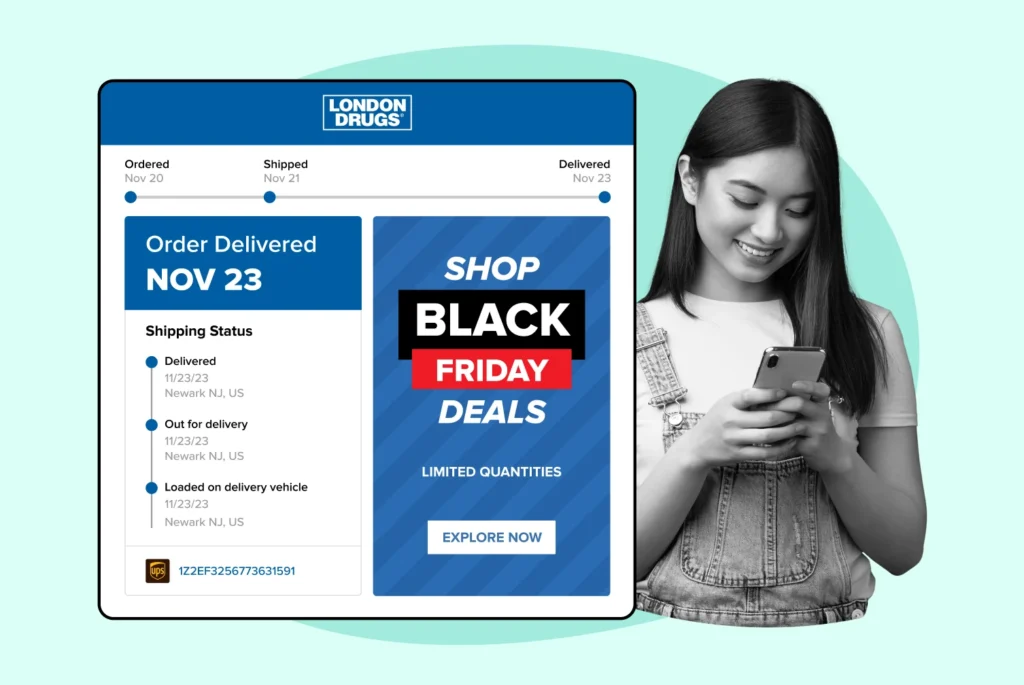
Discover effective BFCM shipping strategies to enhance your sales this holiday season. Maximize efficiency and delight your customers.
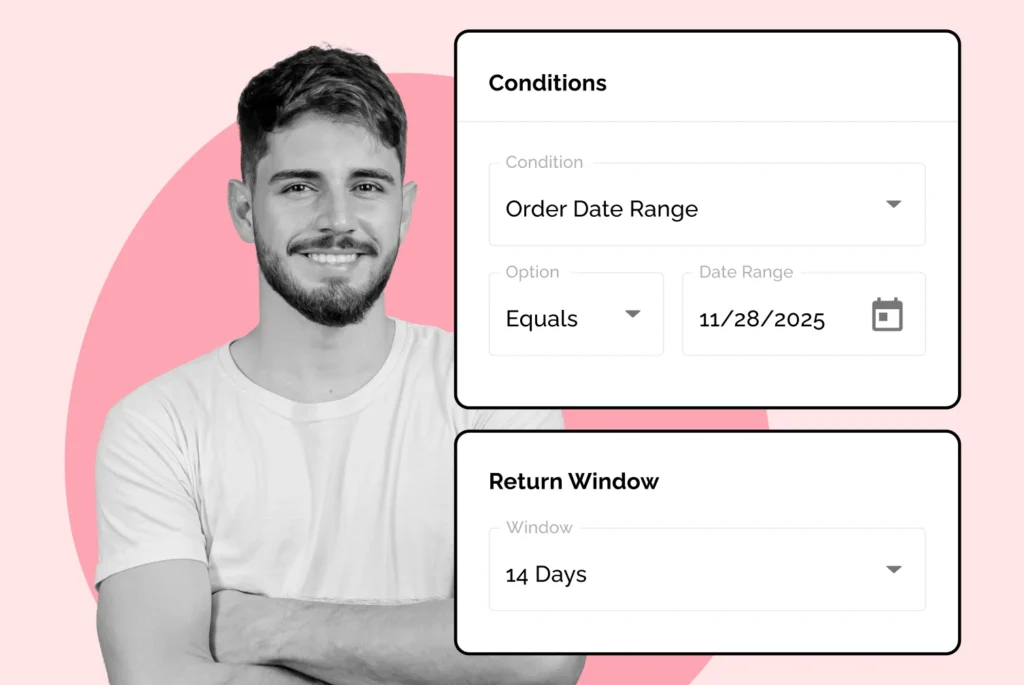
Discover essential strategies to streamline bulk returns handling and enhance efficiency. Read the article for practical tips!
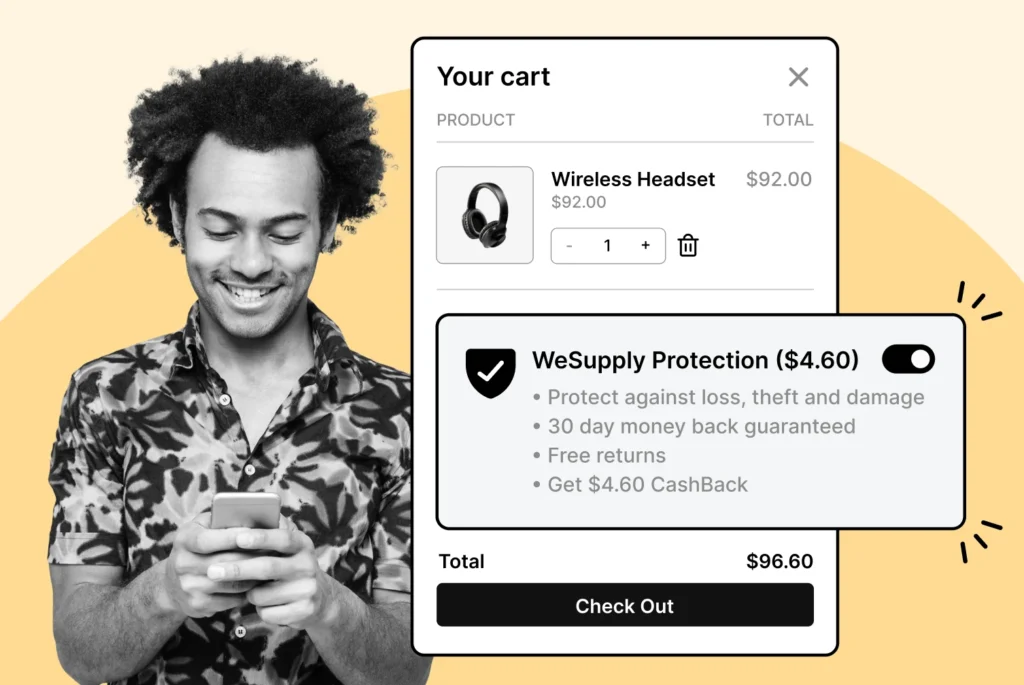
Master post-holiday returns management with effective strategies that streamline processes and enhance customer satisfaction.

Master the art of managing BFCM returns and exchanges with effective strategies that boost eCommerce success.

Discover effective BFCM shipping strategies to enhance your sales this holiday season. Maximize efficiency and delight your customers.
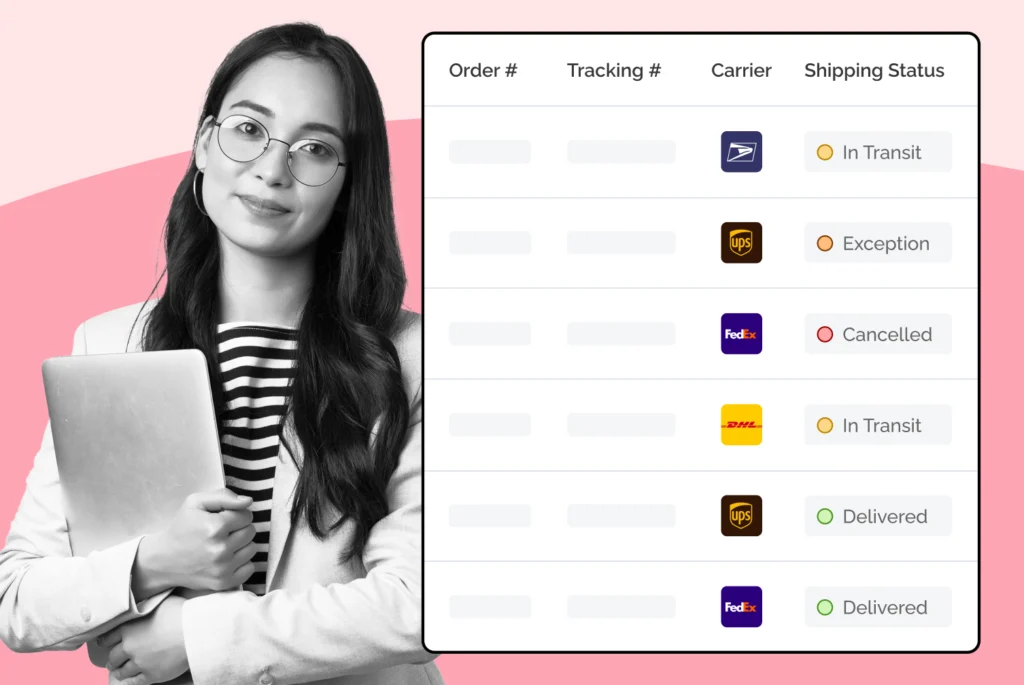
Discover essential strategies to streamline bulk returns handling and enhance efficiency. Read the article for practical tips!

Master post-holiday returns management with effective strategies that streamline processes and enhance customer satisfaction.